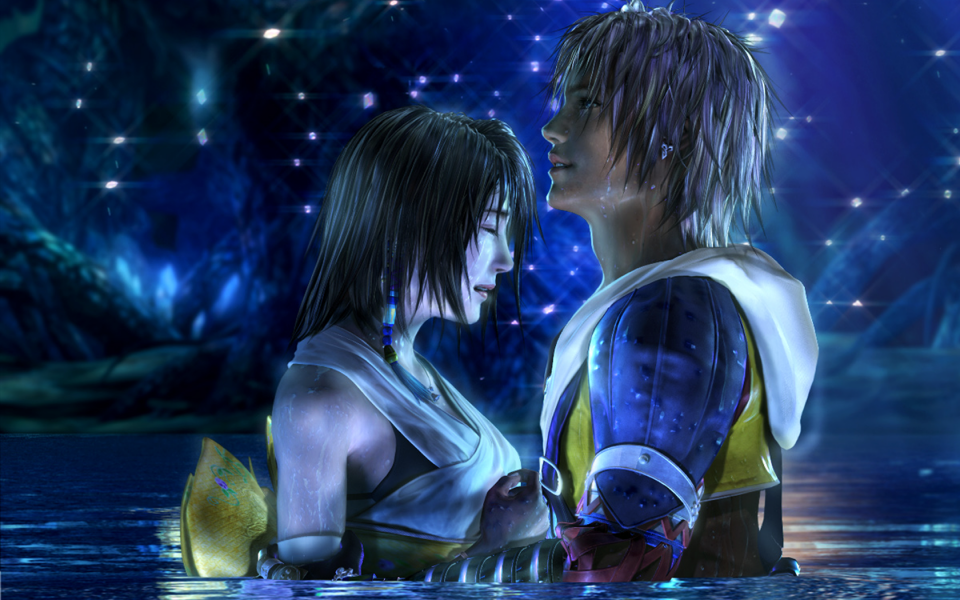Revisiting the Story of Final Fantasy X
By lordgodalming 7 Comments

Although this game came out in 2001, I should give a general spoiler alert if you don’t want the story wrecked for you. Additionally, if my interpretation of the story differs from yours, feel free to share in the comments.*
In 1987 Hironobu Sakaguchi, game director for Final Fantasy, decided he was more suited to storytelling than action, and so began one of the longest running roleplaying game franchises in the world. Twenty-six years and dozens of games later, Final Fantasy X stands out as the deepest and bravest of the series. Why brave? Because it puts religion, a topic usually (and loudly) ignored in video games, smack at the center of its story.
Just how taboo is religion in games? There is a long list of titles, including the original Final Fantasy, that were forced to remove all religious references such as churches and crosses before they could be sold outside Japan, where religion is—and I’m simplifying here—taken less seriously than in many other cultures.
Writing about religion is a real minefield in any medium, mainly because no one has any sense of humor about it. Whatever you say, someone will hate you for it, maybe enough to kill you (ever hear of Salman Rushdie?). My former dentist chastised me when I carried The Da Vinci Code into his office, not because it was woodenly written or intellectually insulting, but because he felt it unfairly maligned the Catholic church. I might have pointed out that the Catholic church didn’t need any help maligning itself in the mid-2000’s, but he was already going to be using needles and drills in my mouth and I didn’t want to give him an excuse to do something even worse.
Final Fantasy X dodges some of the danger by inventing its own religion. Its mythology goes that a thousand years ago a creature named Sin appeared in the form of a giant flying whale monster and began indiscriminately slaughtering whole cities full of people all over the world. Only a single “Summoner,” a woman who could call upon spirits to fight for her, was able to vanquish Sin at the cost of her own life. However, Sin came back a generation later, only to be quieted by the self-sacrifice of yet another Summoner.
Obviously this “invented” religion has a LOT in common with the story of Jesus, the main difference being that each generation in Final Fantasy X needs its own new Jesus to keep Sin at bay. By the time the game begins, this pattern has played out so many times throughout history that there is a specific pilgrimage every Summoner must make across the world in order to have any hope of defeating Sin.
And that pilgrimage is the first stroke of genius in Final Fantasy X’s storytelling. Conveying a living and functioning fantasy world to readers is always a tricky proposition, with a common tactic being to open the story with a wild action set-piece and then spend the next several chapters on exposition and backstory before getting back to the meat of the story.
Final Fantasy X employs this tactic too, but through the perspective of a character who knows exactly as little about the world as the audience does. Once again, a common trick here is to give the lead character amnesia so that it doesn’t seem strange for other characters to offer patient and detailed exposition about the story’s world. Final Fantasy X ditches the amnesiac in favor of a character from a different world. A serviceable if uninspiring substitution.
OR IS IT!
Tidus, the main character, meets the young Summoner Yuna at the beginning of her pilgrimage to defeat Sin. She is quiet, devout and competent, but you also get the sense that she has lived a sheltered life—an obedient lamb raised only for slaughter. Perhaps it is this sheltering that makes her so interested in Tidus. He represents the first companion in her life who knows nothing about her destiny—someone who is interested in her as a person rather than a savior. Dammit if that idea doesn’t give me chills even as I sit here writing about it.
So Tidus becomes one of her guardians on the dangerous pilgrimage, happily unaware—as is the audience!—that each day he is marching his new friend Yuna ever closer to her death. When he does find out, he is understandably furious. He vows to find a way to break the cycle while Yuna’s other guardians share guilty glances. Their job is to keep her alive, sure, but only until it’s time for her to die.
And next comes the masterstroke. Predictably, there is a way to save Yuna, but it comes at a terrible cost. I’ll do my best to explain. Sin, as its name implies, is a physical manifestation of the negative spiritual energy from all previous generations. Each generation a single Summoner uses the pilgrimage to gather enough positive energy to absorb Sin, thereby becoming the next Sin, on and on in a never-ending cycle. But the souls of the dead Summoners persist, unable to move on to the afterlife. All they can do is dream of a world that will provide someone who can break the cycle.
And I mean that literally. The world Tidus comes from is the DREAM of the dead summoners, and through their combined spiritual effort, Tidus has become real and crossed into their world to help break the cycle. Still with me? So when Tidus helps Yuna end Sin once and for all, the dead Summoners’ souls will be free, thus ending the dream. Thus ending Tidus himself.
Now the tables are turned; Tidus is the one hiding his own inevitable demise from Yuna so that the world might exist without Sin. The elegance of it all makes me want to put my head through a window because I’ll never be able to duplicate it in my own storytelling.
Anyway, throughout the pilgrimage there are the requisite religious zealots who first encourage and then try to stop Yuna and her band when they realize she means to stop Sin for good. The religious leaders of the world make a good living on the cycle of Sin, after all, and we get a cathartic Jesus-clearing-out-the-temple scene about two thirds of the way through the game. There is also an evolving love story between Tidus and Yuna, who are each in their own way endearingly clueless about the world, but also determined actors in the story. And I don’t mean “actors” as in performers, but as in effective protagonists who are not passive—characters who act when the situation calls them to do so.
To be fair, some elements of Final Fantasy X are less successful. The game devotes waaaay too much story time to this weird sport that is like rugby but played underwater (some characters can breathe under water; this is never explained). Furthermore, the crossover between Tidus’s and Yuna’s worlds seems to break its own rules whenever doing so is convenient for the story. And as an audio-visual medium, the character design and voice acting can be completely bonkers.
Still, there is much to learn from Final Fantasy X as an exercise in storytelling. For example, the game proves that clichés like a fantasy protagonist who needs every detail of the world explained to him for the audience’s benefit can still be interesting and successful. Another is that it is possible to write about the strengths, weaknesses, and quirks of organized religion without veering into the danger that Mr. Rushdie found himself in after he wrote The Satanic Verses.
But more than either of those things, the simple existence and enduring popularity of Final Fantasy X teaches writers all over the world that any idea, no matter how ambitious, how grand, how bananas it may seem on the surface, can be polished into a story that is widely appealing, compelling, and beautiful.
